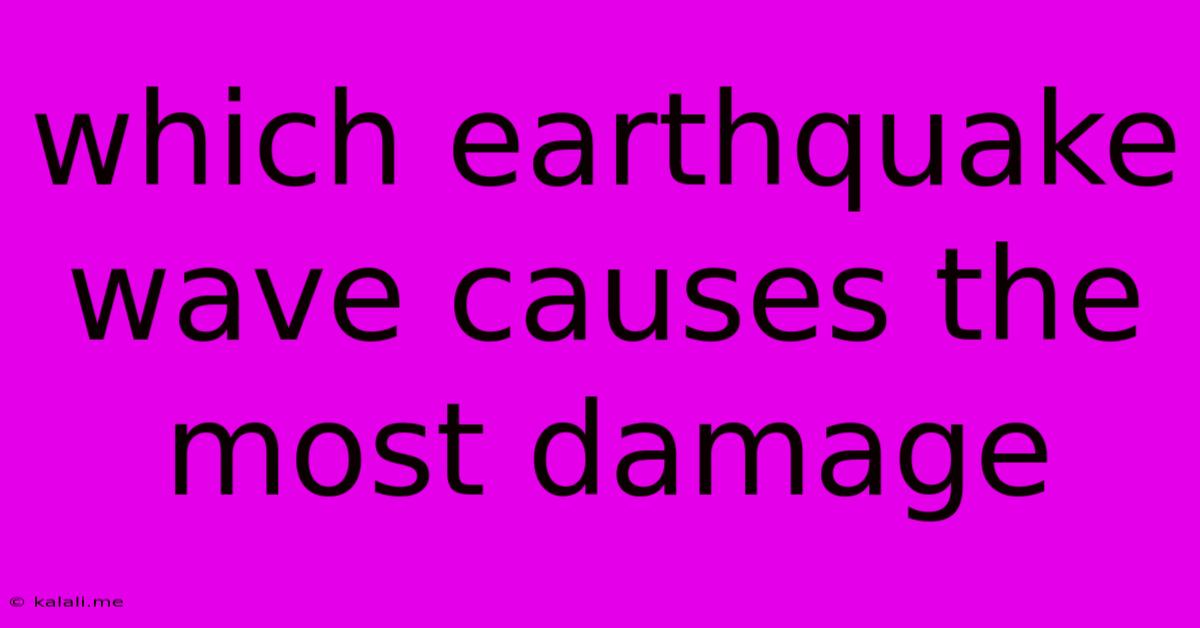Which Earthquake Wave Causes The Most Damage
Kalali
Jun 13, 2025 · 3 min read

Table of Contents
Which Earthquake Wave Causes the Most Damage? Understanding Seismic Waves and Their Impact
Earthquakes, powerful and unpredictable forces of nature, release immense energy that travels in the form of seismic waves. These waves are responsible for the ground shaking we experience, and understanding their different characteristics is crucial to comprehending the devastation caused by earthquakes. While several types of seismic waves exist, surface waves are generally recognized as the most destructive. This article delves into the specifics of why surface waves cause the most damage compared to body waves (P-waves and S-waves).
Understanding Seismic Waves: P-waves, S-waves, and Surface Waves
Earthquakes generate different types of seismic waves, each with unique properties and damaging potential. These waves can be broadly classified into body waves and surface waves.
-
P-waves (Primary waves): These are compressional waves, meaning they travel by compressing and expanding the material they pass through. They are the fastest seismic waves and arrive first at seismograph stations. While they cause some shaking, their relatively small amplitude limits their destructive capacity.
-
S-waves (Secondary waves): These are shear waves, meaning they move particles perpendicular to their direction of travel. Slower than P-waves, they arrive later and cause more pronounced shaking. However, their damage is still less significant compared to surface waves.
-
Surface waves: These waves propagate along the Earth's surface, and are categorized into two main types: Love waves and Rayleigh waves. They are responsible for the most significant ground motion and the majority of the damage associated with earthquakes.
-
Love waves: These waves cause horizontal ground motion, moving the ground back and forth perpendicular to the wave's direction of travel. Their relatively high amplitude contributes significantly to the destructive power of earthquakes.
-
Rayleigh waves: These waves cause rolling motion, similar to ocean waves. They combine both vertical and horizontal ground motion, leading to significant damage to structures. Their large amplitude and slow velocity allow them to propagate for long distances and cause widespread destruction.
-
Why Surface Waves are the Most Destructive
Several factors contribute to the superior destructive potential of surface waves:
-
Higher Amplitude: Surface waves generally possess significantly larger amplitudes than body waves. This larger amplitude translates directly to more intense ground shaking, which can easily topple structures and cause widespread damage.
-
Longer Duration: Surface waves travel more slowly than body waves, meaning they persist for a longer duration at a particular location. This prolonged shaking further amplifies their destructive impact on buildings and infrastructure.
-
Complex Ground Motion: The combination of vertical and horizontal motion in Rayleigh waves and the purely horizontal motion of Love waves leads to complex ground movements. This complexity makes it difficult for structures to withstand the forces, increasing the likelihood of collapse.
-
Resonance Effects: Surface waves can induce resonance in structures, particularly tall buildings. If the frequency of the wave matches the natural frequency of a building, the shaking can be amplified dramatically, leading to structural failure.
Mitigating Earthquake Damage
Understanding the destructive power of surface waves is crucial for developing effective earthquake mitigation strategies. This includes:
-
Seismic Design: Designing buildings and infrastructure to withstand the intense shaking caused by surface waves through earthquake-resistant construction techniques.
-
Early Warning Systems: Implementing advanced warning systems to provide crucial time for evacuation and preparedness before the arrival of destructive surface waves.
-
Land-Use Planning: Careful planning to avoid building critical infrastructure in areas highly susceptible to significant surface wave amplification.
In conclusion, while P-waves and S-waves contribute to the overall shaking experienced during an earthquake, it's the surface waves—Love and Rayleigh waves—that cause the most significant damage due to their higher amplitude, longer duration, complex ground motion, and potential for resonance effects. Understanding these differences is essential for effective earthquake preparedness and mitigation efforts.
Latest Posts
Latest Posts
-
Animals Store Carbohydrates In The Form Of
Jun 14, 2025
-
What Is The Lcm Of 30 And 45
Jun 14, 2025
-
What Is The Least Common Multiple Of 11 And 6
Jun 14, 2025
-
Precision Can Be Defined As The
Jun 14, 2025
-
A Change In Velocity Is Known As
Jun 14, 2025
Related Post
Thank you for visiting our website which covers about Which Earthquake Wave Causes The Most Damage . We hope the information provided has been useful to you. Feel free to contact us if you have any questions or need further assistance. See you next time and don't miss to bookmark.